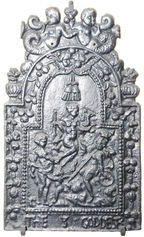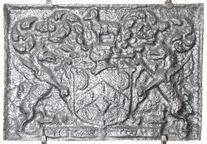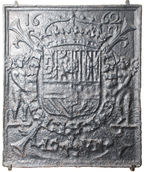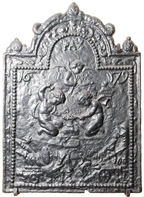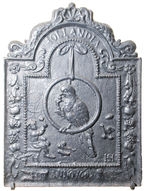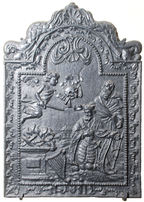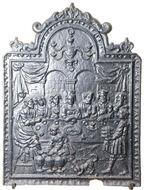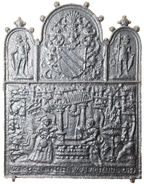-
582
Description: Arched shape with ovolo-moulded edging; figure of a classical warrior with plumed helmet and shield, holding a sword in his right hand; inscription to left of head, probably continued to right by now no longer visible.
Notes: An unusually striking fireback of simple design.
Inscription: ANNO ...
- Decoration tags:
- rounded arched (shape)
- ovolo (edging)
- whole carved pattern
- pictorial
- mythological
- text
- humans
Manufactured: in the mid- to late-17th century possibly in the Lorraine area of Germany.
Current location: Petworth House, Petworth, West Sussex, England.
Museum number: NT/PET/M/73 (part of the National Trust museum group)
- Attached to series:
- Miscellaneous pattern firebacks
- 'Dutch' Miscellaneous Firebacks
-
520
Description: Arched rectangular central panel with bead edging; with tassel at top; three nude female figures: on top, Juno/Hera with a peacock, to the left Venus/Aphrodite, the young cupid/Eros at her feet, to the right Minerva/Athena with spear and shield; arched rectangular border with fillet edging; the heads of two putti and from them two suspended festoons of fruit and leaves; at the bottom, the inscription, THE 3 GODDESES, widely spaced. On top, two figures of Triton blowing seashells. On each shoulder of the fireback, a fluted vase with flowers issuing.
Notes: The three eponymous goddesses are those whose beauty was the subject of the Judgement of Paris. The composition is copied from an engraving by Adriaen Collaert (c1560-1618). This fireback is an instance of a continental back which has been recast in England, the opportunity being taken to insert an English inscription in place of the customary date and pattern maker's monogram
Copies of this fireback are known.
Inscription: THE 3 GODDESES [sic]
- Decoration tags:
- 'Dutch' (shape)
- fillet (edging)
- whole carved pattern
- planklines
- pictorial
- mythological
- text
Manufactured: in the late-17th century in England.
Current location: Petworth House, Petworth, West Sussex, England.
Museum number: NT/PET/M/74 (part of the National Trust museum group)
- Attached to series:
- 'Dutch' NDW series
- Judgement of Paris firebacks
-
521
Description: Rectangular with arched, mirrored scrolls on top and central scallop shell; fillet edging; Pan, with a goat behind, trees to left and right; a putto above right; at the bottom, a separate rectangular panel with mirrored scrolled foliage.
Notes: A scene apparently unrelated to a specific classical narrative, and without the customary decorated border.
Copies of this fireback are known.
- Decoration tags:
- rectangular with ornate arch (shape)
- fillet (edging)
- whole carved pattern
- pictorial
- mythological
- animals
- humans
- plants
Manufactured: in the early-18th century in England.
Current location: Petworth House, Petworth, West Sussex, England.
Museum number: NT/PET/M/75 (part of the National Trust museum group)
- Attached to series:
- Late pictorial series (all)
- Late pictorial series 2
-
522
Description: Rectangular; cavetto-moulded edging; shield, helm, crest, supporters, mantling and motto of the Worshipful Company of Clothworkers: Sable a chevron ermine between in chief two Havettes Argent and in base a Teazel Cob Or; crest: on a Mount vert a Ram statant Or; supporters: two Griffins Or pellettée.
Notes: The arms as displayed were granted in 1587; the same fireback was also used as a stamp for a large fireback of 1659 in Haslemere Museum (no. 108).
Arms: Worshipful Company of Clothworkers
- Decoration tags:
- rectangular (shape)
- cavetto (edging)
- whole carved pattern
- armorial
Manufactured: in the early- to mid-17th century possibly in the Weald area of England.
Current location: Petworth House, Petworth, West Sussex, England.
Museum number: NT/PET/M/76 (part of the National Trust museum group)
- Attached to series:
- Livery company firebacks
-
524
Description: Rectangular; cavetto-moulded edging; shield, crown and supporters of King Philip IV of Spain, incorporating the arms of Castille and Leon, Aragon - Sicily, Granada, Portugal, Austria, Burgundy and Brabant; around the shield is the chain of the Order of the Golden Fleece; at the top, the date split by the crown; behind, crossed lilies.
Notes: By 1662 the arms of Portugal were redundant on the Spanish royal arms, but were retained until after the death of Philip IV; the word, LOVEN, indicates the particular association of this plate with the town of Leuven, the capital of Brabant in what was, at the time, part of the Spanish Netherlands.
Inscription: 16 62 / LO VEN
Arms: King Philip IV of Spain
- Decoration tags:
- rectangular (shape)
- double fillet (edging)
- whole carved pattern
- individual numbers
- armorial
- royal
- text
Manufactured: in 1662 possibly in the Eifel area of Germany.
Current location: Petworth House, Petworth, West Sussex, England.
Museum number: NT/PET/M/78 (part of the National Trust museum group)
- Attached to series:
- Foreign armorial firebacks
-
525
Description: Arched rectangular central panel with bead edging; pictorial scene of two putti bent over a central anvil, with a third putto above; below are martial symbols (cannon, banners etc.); in the arch the word 'PAX', and in the shoulders of the panel, the date in two parts; arched rectangular boreder with fillet edging, and foliage draped from the top; on top, a pomegranate to which ascends a serpent on each side, with a further pomegranate on each shoulder of the plate.
Notes: The scene may be intended to represent the infant Vulcan.
Inscription: PAX / 16 79
- Decoration tags:
- 'Dutch' (shape)
- fillet (edging)
- whole carved pattern
- individual numbers
- pictorial
- mythological
- text
- humans
- objects
Manufactured: in 1679 possibly in the Siegerland area of Germany.
Current location: Petworth House, Petworth, West Sussex, England.
Museum number: NT/PET/M/79 (part of the National Trust museum group)
- Attached to series:
- 'Dutch' Miscellaneous Firebacks
-
526
Description: Arched rectangular central panel with bead on fillet edging; suspended from the top, by a ribbon, a ring with a popinjay, or parrot perched thereon, biting a twig in its right claw; below left is a seated child, and in the bottom corners the initial and monogram; around this panel is an arched rectangular border with fillet edging, at the top of which is the word, HOLLANDIA, between scrolls, with swags of fruit hung on ribbons suspended from roses down each side; at the bottom, a motto scroll bearing the inscription, ANNO 16 ...; on top, a central scallop shell between two dolphins.
Notes: A common design among firebacks produced in Germany for the Dutch market.
Copies of this fireback are known.
Inscription: HOLLANDIA / H HS / ANNO 16 ...
- Decoration tags:
- 'Dutch' (shape)
- cavetto (edging)
- whole carved pattern
- pictorial
- allegorical
- monogram
- text
- animals
- humans
- objects
Manufactured: in the mid- to late-17th century in the Siegerland area of Germany.
Current location: Petworth House, Petworth, West Sussex, England.
Museum number: NT/PET/M/70 (part of the National Trust museum group)
- Attached to series:
- 'Dutch' Bird on perch firebacks
-
527
Description: Arched rectangular central panel with bead edging terminating at the top in two loops, gather drapery and a scallop shell; two figures to the right, both bearded, the one kneeling wears cavalry armour, a cloak and a crown, the other stands behind; to the left is a sacrificial pyre on which an ox carcass burns, and above an angel carrying a sword in his right hand and a skull in his left; around this is an arched rectangular border with fillet edging and a repeated leaf pattern; on top is a scallop shell between two dolphins.
Notes: The scene illustrates the visitation of the pestilence on Israel described in 2 Samuel 24, and the sacrifice of an oxen by King David; the skull borne by the angel represents the death of those struck down by the plague. A slightly different version has the face of David looking up at the angel (no. 424).
Copies of this fireback are known.
Manufactured: in the mid- to late-17th century in the Siegerland area of Germany.
Current location: Petworth House, Petworth, West Sussex, England.
Museum number: NT/PET/M/81 (part of the National Trust museum group)
-
528
Description: Arched rectangular central panel with bead edging; pictorial scene of seven figures, the central one crowned, seated at a table laid with cups and dishes, with two other figures, one at the front, the other to the right, serving them; below are martial symbols (cannon, banners etc.); behind the figures are two archways with drapery at the side, and a chandelier above; arched rectangular border with fillet edging, and egg-and-dart moulding on top and sides; on top, a diamond within a cartouche, and the same on each shoulder of the plate; descending from the top, a serpent on each side.
Notes: The scene is of the marriage at Cana (John 2), a biblical story often portrayed on firebacks and stoveplates.
- Decoration tags:
- 'Dutch' (shape)
- fillet (edging)
- whole carved pattern
- pictorial
- biblical
- architectural
- humans
Manufactured: in the mid- to late-17th century in the Siegerland area of Germany.
Current location: Petworth House, Petworth, West Sussex, England.
Museum number: NT/PET/M/82 (part of the National Trust museum group)
- Attached to series:
- 'Dutch' Miscellaneous Firebacks
- New Testament firebacks
-
529
Description: Rectangular with three arches, the middle one larger than the outer two; cavetto-moulded edging; bottom panel, pictorial scene of Jesus and the woman of Samaria at the well (John 4), with other figures, buildings etc. in the background, illegible text below; centre arch, shield, helm, crest and mantling of unidentified arms, the initials 'GP' in bottom corners; left arch, probable figure of a saint; right arch, probable figure of a soldier.
Notes: The combination of a biblical scene (John 4) with a coat of arms.
Inscription: 16 30 / G P
- Decoration tags:
- rectangular with three arches (shape)
- cavetto (edging)
- whole carved pattern
- pictorial
- biblical
- armorial
- text
- humans
Manufactured: in 1630 possibly in the Eifel area of Germany.
Current location: Petworth House, Petworth, West Sussex, England.
Museum number: NT/PET/M/83 (part of the National Trust museum group)
- Attached to series:
- New Testament firebacks
- Foreign armorial firebacks

